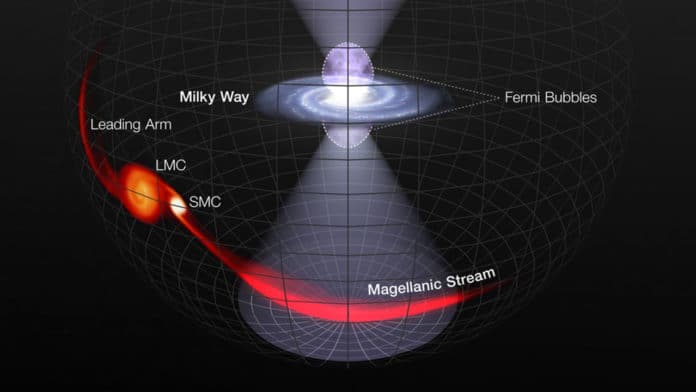A supermassive black hole in the center of the Milky Way galaxy exploded an enormous outburst almost 3.5 million years ago. The black hole, known as Sagittarius A, or Sgr A* exploded due to a large hydrogen cloud falling onto the disk of material swirling near the central black hole, and its floodlight reached so far of our galaxy.
Now, using NASA’s Hubble Space Telescope’s, astronomers to uncover even more clues about this cataclysmic explosion. Looking to the most distant edges of our galaxy, they found that the black hole‘s floodlight ventured so far into space that it lit up an immense train of gas trailing the Milky Way’s two prominent satellite galaxies: the Large Magellanic Cloud (LMC) and its buddy, the Small Magellanic Cloud (SMC).
The outburst sent cones of blistering ultraviolet radiation above and beneath the plane of the galaxy and eep into space.
The radiation cone that impacted out of the Milky Way‘s south pole lit up a large ribbon-like gas structure called the Magellanic Stream. The flash lit up a portion of the stream, ionizing its hydrogen (enough to make 100 million Suns) by stripping atoms of their electrons.
Principal Investigator Andrew Fox of the Space Telescope Science Institute (STScI) in Baltimore said, “The flash was so powerful that it lit up the stream like a Christmas tree — it was a cataclysmic event! This shows us that different regions of the galaxy are linked — what happens in the galactic center makes a difference to what happens out in the Magellanic Stream. We’re learning about how the black hole impacts the galaxy and its environment.”
Using Hubble’s ultraviolet capabilities, astronomers identified the stream by using background quasars as light sources. They studied sightlines to 21 quasars far behind the Magellanic Stream and ten behind another feature called the Leading Arm.
STScI’s Elaine Frazer, who analyzed the sightlines and discovered new trends in the data, said, “When we look at the quasar light spectrum at specific wavelengths, we see evidence of light absorption that we wouldn’t see if the light hadn’t passed through the cloud. From this, we can conclude the gas itself.”
Astronomers also found that the enormous outburst generated ions in the Magellanic Stream. And it was so powerful that it lit up the stream, even though this structure is about 200,000 light-years from the galactic center.
Unlike Magellanic Stream, astronomers did not found any evidence that the outburst lit up the Leading Arm. It may be because the Leading Arm is not sitting right below the south galactic pole, so it was not showered with the burst’s radiation.
The same event that caused the radiation flare also “burped” hot plasma that is now towering about 30,000 light-years above and below the plane of our galaxy. These invisible bubbles, weighing the equivalent of millions of Suns, are called the Fermi Bubbles.
Fox said, “We always thought that the Fermi Bubbles and the Magellanic Stream were separate and unrelated to each other and doing their things in different parts of the galaxy’s halo. Now we see that the same powerful flash from our galaxy’s central black hole has played a major role in both.”
Journal Reference:
- Andrew J. Fox et al., Kinematics of the Magellanic Stream and Implications for its Ionization. DOI: 10.17909/t9-94ka-p284
